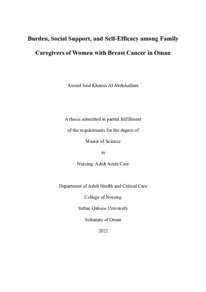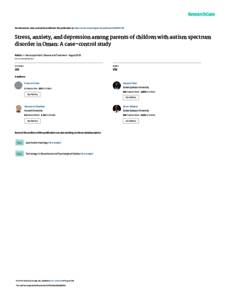Document
Burden, social support, and self-efficacy among family caregivers of women with breast cancer in Oman.
Publisher
Sultan Qaboos University.
Gregorian
2022
Language
English
English abstract
Background: Assessing the burden of the most common types of cancer, including breast
cancer, is one of the main health research priorities in the Sultanate of Oman. Family
caregivers perform many activities that were previously performed by health professionals.
Due to the rising incidence of breast cancer and the shorter length of hospital stays, more
pressure is being placed on family members to take care of their close relatives who are ill.
However, studies that investigate caregivers' burdens in Middle Eastern countries, including
Oman, are limited.
Aim: The main aims of the study were to describe the levels of burden, social support, and
self-efficacy among family caregivers of women with breast cancer, as well as the
relationship among these variables. In addition, the study aimed to examine the relationships
of the burdens to the selected medical and sociodemographic variables of patients and
caregivers.
Method: The study employed a descriptive cross-sectional design to describe the level of
burden, the social support, and the self-efficacy among family caregivers. The Zarit Burden
Interview (ZBI), the Multidimensional Scale of Perceived Social Support (MSPSS) and the
General Self-efficacy (GSE) scale were used to measure the levels of the three variables. The
family caregivers were recruited from two leading hospitals in Oman, namely the Sultan
Qaboos University Hospital and the Royal Hospital.
Results: The caregiver burden was low (M = 15.89, SD = 12.89). More than half of the
participants reported a high level of perceived social support (M = 5.14, SD 1.49) and self efficacy (M = 3.03, SD = 0.52). The high burden was associated with the age of the
caregivers and the relationship of the caregiver to the patient. In addition, family subscales
for social support (r = − 0.181, p = 0.043) and self-efficacy (r = - 0.266, p = 0.011) were
negatively associated with burdens.
Conclusion: The results emphasized the need for health professionals to conduct early
assessments to identify caregiver burdens, and to consider both patients and their caregivers
when establishing management strategies. The findings also emphasized the role of family
support and self-efficacy in reducing family caregivers' burdens, thus indicating the need for
more strategies at the community level to ensure that caregivers are receiving the required
support that can help to decrease their burdens as caregivers.
Member of
Resource URL
Arabic abstract
المقدمة: تقييم العبء بين أنواع السرطان الأكثر شيو ًعا ، بما في ذلك سرطان الثدي ، يعد احد أهم أولويات البحوث الصحية في سلطنة عمان. يقوم مقدمو الرعاية لذويهم المرضى بالسرطان بالعديد من الأنشطة التي تقدم للمرضى في المرافق الصحية من قبل المتخصصين الصحيين. مع ارتفاع معدل الأصابة بسرطان الثدي وقصر فترات الأقامة في المستشفى ، يترتب على هذا فرض مزيد من الضغط على أفراد الأسرة اثناء رعايتهم لمرضاهم. عموما" ، فإن الدراسات التي بحثت في العبء المترتب على مقدمي الرعاية لذويهم المرضى في دول الشرق الأوسط ، بما في ذلك عمان ، محدودة جدا". الهدف : تتمثل الأهداف الرئيسية للدراسة في قياس مستوى العبء والدعم الأجتماعي والكفاءة الذاتية بين مقدمي الرعاية الأسرية للنساء المصابات بسرطان الثدي والعلاقة بين هذه المتغيرات الثالثة. بالأضافة إلى ذلك ، تهدف إلى استكشاف العلاقة بين العبء والمواصفات الديموغرافية والعوامل الصحية للمريض ورعاتهم. التصميم وطرق العمل: تم استخدام تصميم ارتباط وصفي مقطعي باستخدام استبيانات حول العبء والدعم الأجتماعي والكفاءة الذاتية. حيث تم استخدام مقابلة عبء زاريت )ZBI )لحساب مستوى العبء ، و المقياس متعدد الأبعاد للدعم الأجتماعي المتصور )MSPSS )لتقييم مستوى الدعم الأجتماعي و مقياس الكفاءة الذاتية العام )GSE )لقياس مستوى الكفاءة الذاتية. تم اختيار المشاركين في الدراسة من مستشفيين رئيسيين في عمان: مستشفى جامعة السلطان قابوس والمستشفى السلطاني. النتائج: اظهرت النتائج مستوى عبء منخف ًضا .(12.89 = SD 15.89, = M(بين رعاة النساء المصابات بسرطان الثدي. اظهر اكثر من نصف المشاركين مستويات عالية من الدعم الأجتماعي (1.49 SD 5.14, = M (و الكفاءة الذاتية (0.52 = SD 3.03, = M (.ارتبط العبء المرتفع بعمر مقدمي الرعاية وعالقة مقدمي الرعاية بالمريض. بالأضافة إلى ذلك ، ارتبطت المستويات الفرعية لألسرة للدعم الأجتماعي (0.043 = p 0.181, − = r (والكفاءة الذاتية ارتبا . ًط (0.011 = p 0.266, - = r (ا سلبيًا بالعبء الخالصة: تؤكد النتائج على الحاجة إلى المهنيين الصحيين إلجراء تقييم مبكر لتحديد عبء مقدم الرعاية والنظر في كل من المرضى ومقدمي الرعاية لهم عند وضع استراتيجيات وخطط العالج. أكدت النتائج أي ًضا على دور دعم الأسرة والكفاءة الذاتية في تقليل عبء مقدمي الرعاية لذويهم المرضى، مما يشير إلى الحاجة إلى مزيد من الأستراتيجيات على المستوى المجتمعي لضمان تلقي مقدمي الرعاية الدعم المطلوب والكافي الذي يمكن أن يساعدهم في تقليل العبء الناتج أثناء تقديم الرعاية.
Category
Theses and Dissertations


